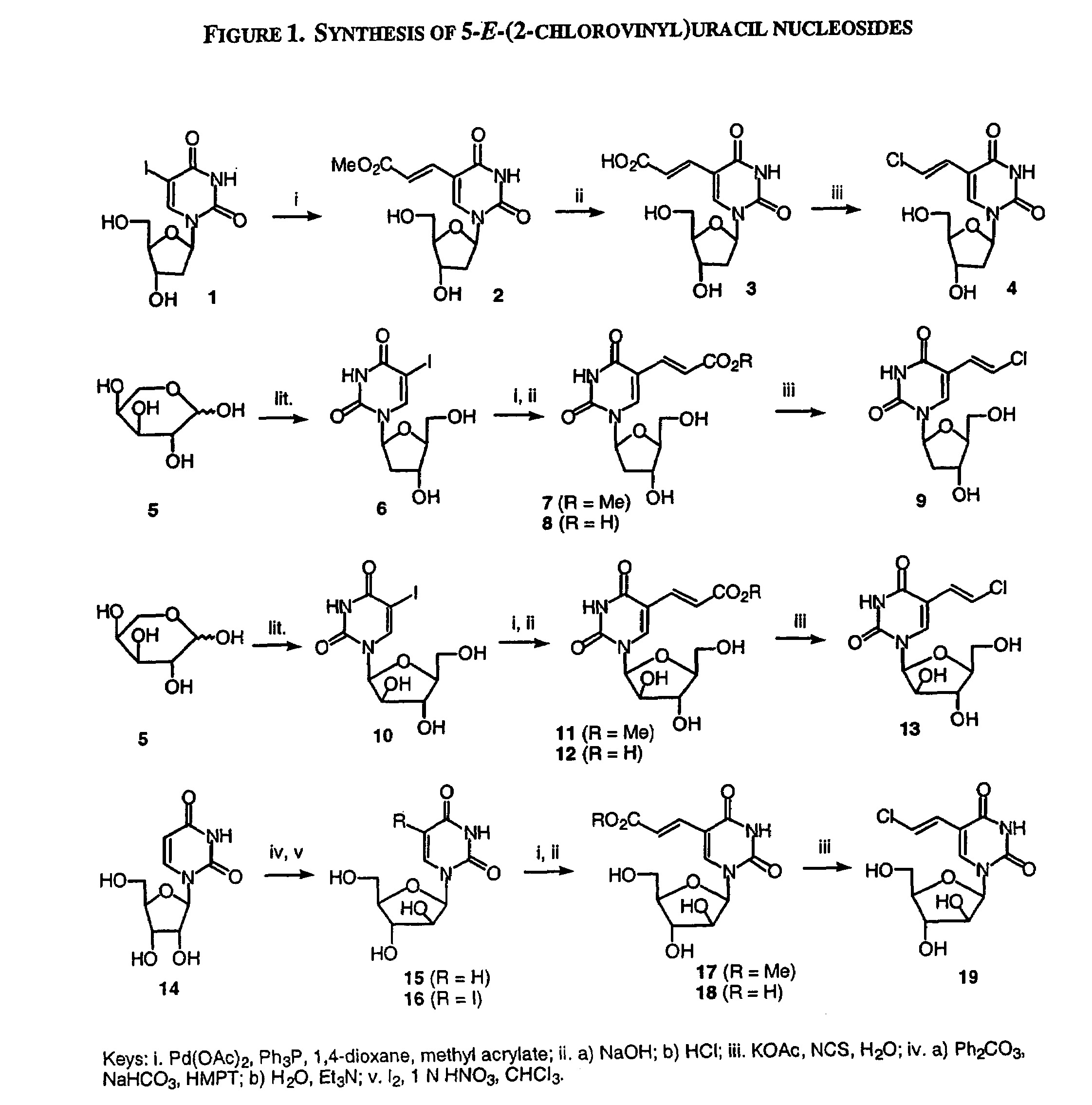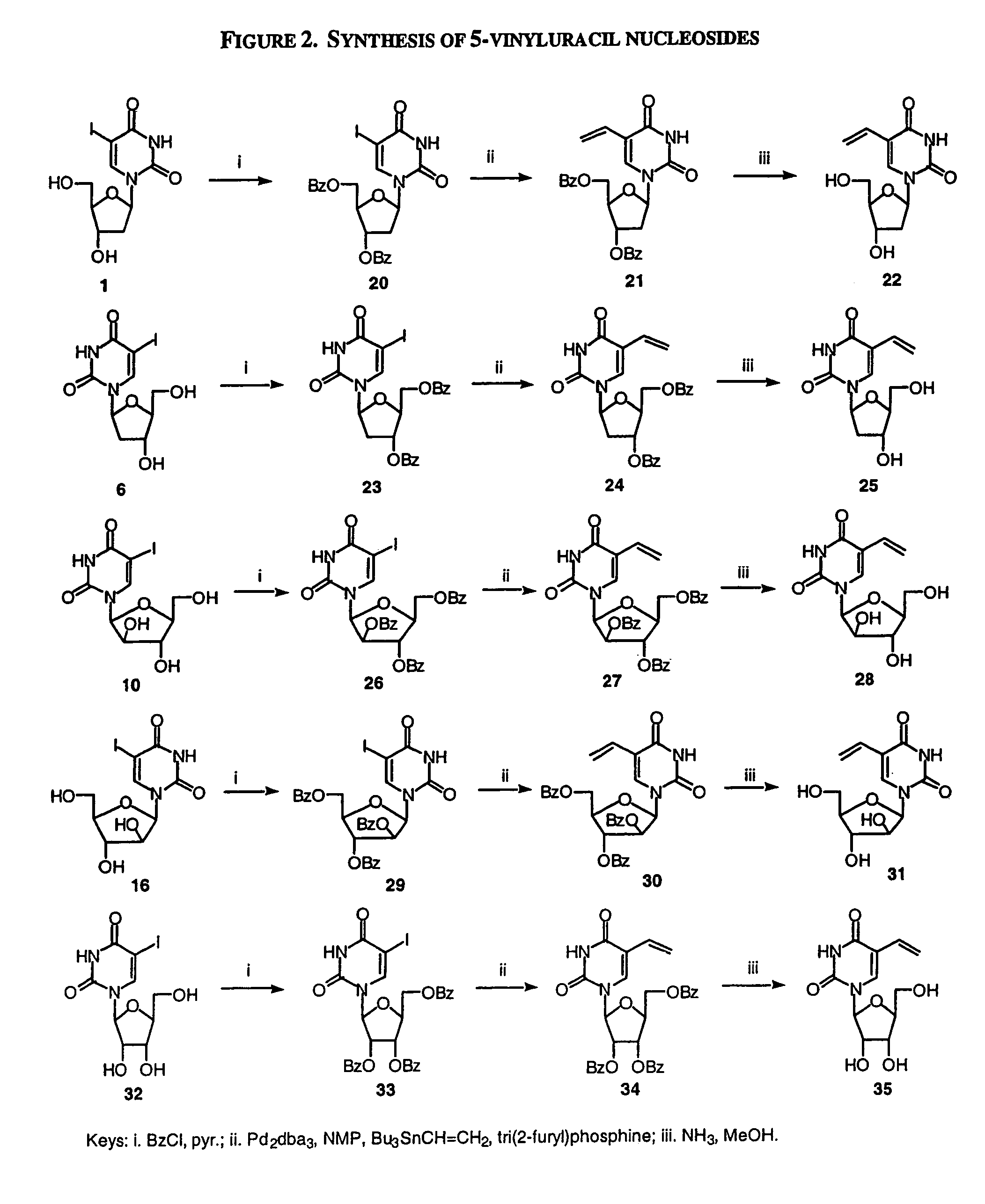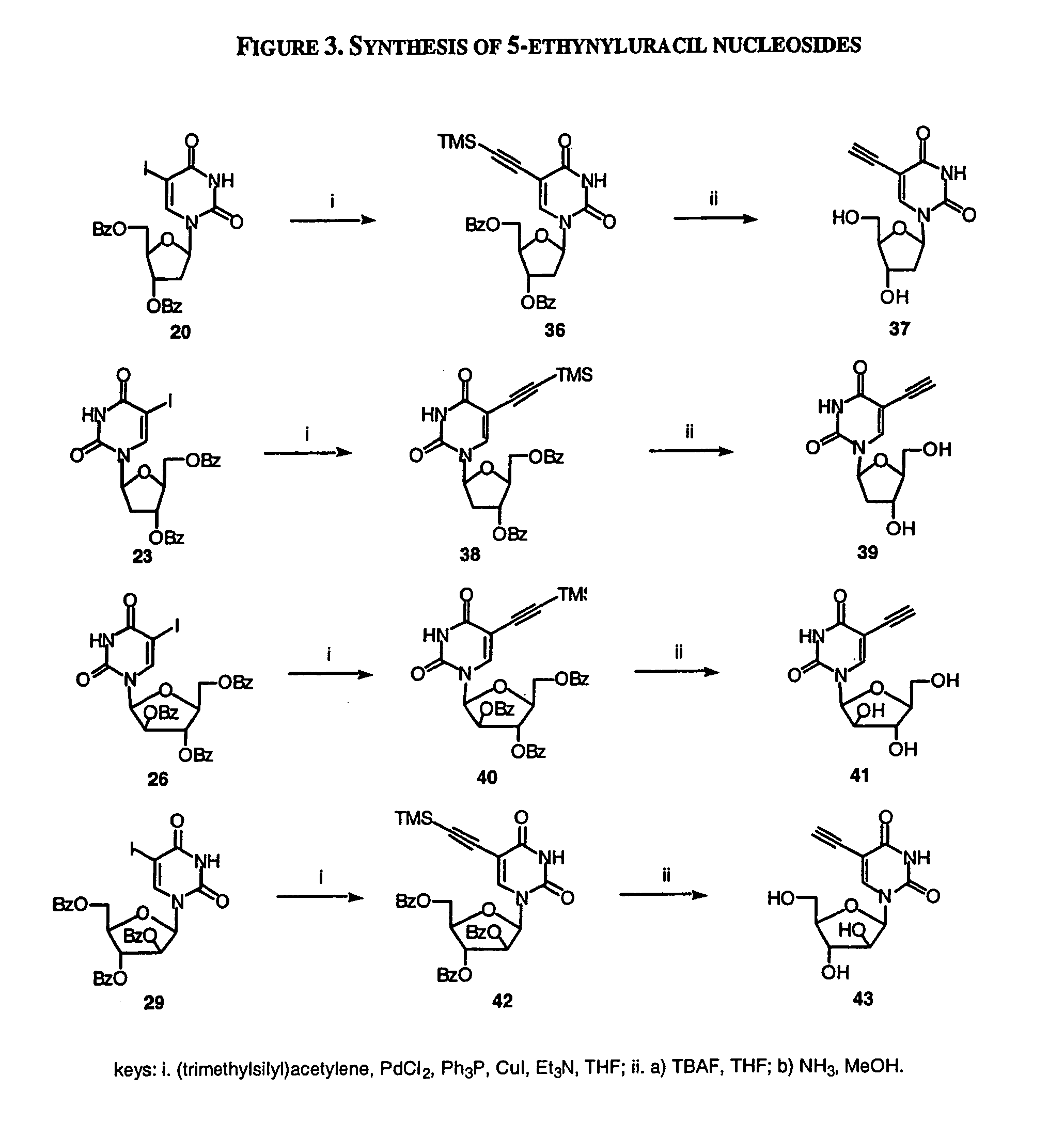Treatment of EBV and KHSV infection and associated abnormal cellular proliferation
a technology of khsv infection and ebv, which is applied in the field of treatment of ebv and khsv infection and associated abnormal cellular proliferation, and achieves the effect of inhibiting ebv or khsv growth
- Summary
- Abstract
- Description
- Claims
- Application Information
AI Technical Summary
Benefits of technology
Problems solved by technology
Method used
Image
Examples
example 1
β-D-5-E-(2-Carbomethoxyvinyl)-2′-deoxyuridine (2)
[0266]To a solution of Pd(OAc)2 (96 mg, 0.42 mmol) and Ph3P (240 mg, 0.92 mmol) in 1,4-dioxane (90 mL) was added 2′-deoxy-5-iodouridine (1, 2.68 g, 7.56 mmol), followed by methyl acrylate (1.6 mL, 19.78 mmol). The mixture was heated at reflux under nitrogen atmosphere for 16 h. The hot mixture was filtered through a pad of celite, and the celite was rinsed with hot 1,4-dioxane. The combined filtrate was concentrated in vacuo, and the residue was purified by flash chromatography on silica gel eluting with CH2Cl2 / MeOH (85:15 to 75:25) to give the title compound 2 as a pale yellow solid (2.17 g, 92%). 1H NMR (DMSO-d6) δ 8.42 (s, 1H, H-6), 7.37, 6.85 (2d, J=16 Hz, 2H, CH═CH), 6.12 (t, J=6.4 Hz, 1H, H-1′), 5.28 (d, J=4.4 Hz, 1H, OH), 5.19 (t, J=5.2 Hz, 1H, OH), 4.25 (m, 1H, H-3′), 3.81-3.78 (m, 1H, H-4′), 3.68 (s, 3H, CH3), 3.66-3.56 (m, 2H, H-5′), 2.19-2.15 (m, 2H, H-2′).
[0267]In an analogous manner to the preparation of compound 2, β-L-5...
example 2
β-2′-Deoxy-5-E-(2-chlorovinyl)uridine (4)
[0276]A solution of 2 (1.25 g, 4.0 mmol) in aqueous NaOH (1 N, 50 mL) was stirred at room temperature overnight. The solution was cooled to 0° C. and brought to pH 2 by the addition of 4 N HCl. The mixture was stand in ice for 30 minutes, and the white precipitate was filtered. The filtrate was evaporated to dryness in vacuo and water was added. The resulting precipitate was filtered and washed with water. The combined precipitate was dissolved in water (40 mL) by heating with KOAc (1.96 g, 20 mmol), and N-chlorosuccinimide (536 mg, 4.0 mmol) was added portion-wise. The solution was heated at reflux for 3 h, and then concentrated in vacuo. The residue was purified by flash chromatography on silica gel eluting with CH2Cl2 / MeOH (9:1) to give the title compound 3 as a white solid (438 mg, 38%). 1H NMR (DMSO-d6) δ 11.6 (s, 1H, NH), 8.06 (s, 1H, H-6), 7.18, 6.59 (2d, 2H, J=13.2 Hz, CH═CH), 6.13 (t, J=6.4 Hz, 1H, H-1′), 5.28 (d, J=4.0 Hz, 1H, OH-3′...
example 3
1-(β-D-Arabinofuranosyl)uracil (15)
[0282]A mixture of uridine (14; 13.25 g, 54.5 mmol), diphenyl carbonate (15.48 g, 72.5 mmol), anhydrous NaHCO3 (349 mg, 4.15 mmol), and hexamethylphosphoric triamide (50 mL) was heated with stirring at 150° C. under nitrogen for 20 min, and then cooled to room temperature. The mixture was poured into cold water (400 mL), and washed with CHCl3. Et3N (25 mL) was added, and the aqueous solution was heated at 70° C. for 5 h. The solvent was evaporated in vacuo, and the residue was crystallized from MeOH / water to give the title compound 15 as a white solid (11.13 g, 84%). 1H NMR (DMSO-d6) δ 11.2 (s, 1H, NH), 7.60 (d, J=7.5 Hz, 1H, H-6), 5.95 (d, 1H, H-1′), 5.51 (d, J=7.5 Hz, 1H, H-5), 6.30-5.30 (br, 2H, 2 OH), 4.10-3.50 (m, 6H, H-2′, H-3′, H-4′, H-5′, OH).
PUM
 Login to View More
Login to View More Abstract
Description
Claims
Application Information
 Login to View More
Login to View More - R&D
- Intellectual Property
- Life Sciences
- Materials
- Tech Scout
- Unparalleled Data Quality
- Higher Quality Content
- 60% Fewer Hallucinations
Browse by: Latest US Patents, China's latest patents, Technical Efficacy Thesaurus, Application Domain, Technology Topic, Popular Technical Reports.
© 2025 PatSnap. All rights reserved.Legal|Privacy policy|Modern Slavery Act Transparency Statement|Sitemap|About US| Contact US: help@patsnap.com



